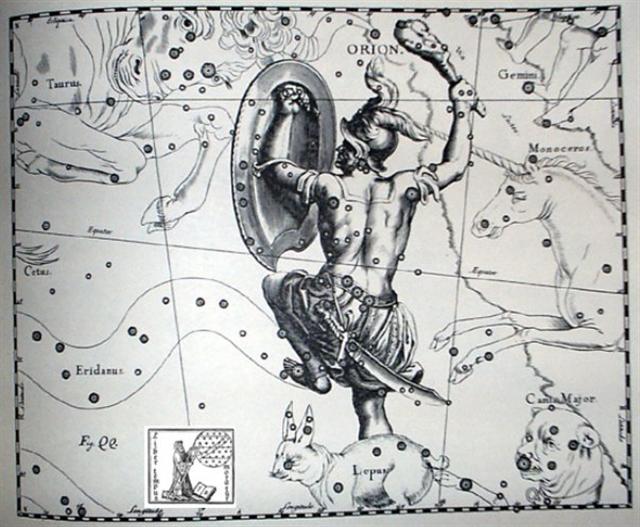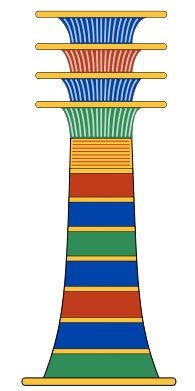Right ascension 05h 00m corresponds to right ascension day 5 / 24 * 365¼ = 76, which is June 5. In rongorongo times (ca 1870 A.D.) e.g. ε Leporis would have risen heliacally in this day:
 |
 |
 |
 |
| Ka1-7 |
Ka1-8 |
Ka1-9 |
Ka1-10 (*74) |
| |
|
|
Hassaleh (73.6) |
| May 31 (151) |
June 1 |
2 |
3 |
| Pleione 1 (15) |
2 |
3 |
4 |
 |
 |
(4) |
 |
 |
(1) |
| Ka1-11 (*75) |
Ka1-12 |
*Ka1-17 (13) |
*Ka1-18 (14) |
| Almaaz (74.7), Haedus I (74.8) |
Haedus II (75.9), ε Leporis (76.0), Cursa (76.4) |
λ Eridani (76.7) |
μ Leporis (77.6), ĸ Leporis (78.0), Rigel (78.1), Capella (78.4) |
| June 4 |
5h (76.1) |
June 6 (157) |
7 |
| Pleione 5 |
6 (20) |
Pleione 7 |
8 (22) |
 |
 |
 |
 |
 |
| *Ka1-20 (15) |
*Ka1-21 (*80) |
*Ka1-22 (17) |
*Ka1-23 (18) |
*Ka1-24 (19) |
| |
λ Leporis (79.6) |
Bellatrix, Saif al Jabbar (80.7), Alkab (80.9) |
Nihal (81.7), Mintaka (82.4) |
ε Columbae (82.6), Arneb (83.0), φ¹ Orionis (83.1), Heka (83.2), Hatysa (83.5) |
| June 8 |
9 |
10 |
11 |
12 (163) |
| Pleione 9 |
10 (24) |
11 |
12 |
13 |
 |
 |
 |
 |
| Ka2-1 (20) |
Ka2-2 (*85) |
Ka2-3 |
Ka2-4 |
| φ² Orionis (83.6), Alnilam (83.7), Heavenly Gate (84.0) |
Alnitak, Phakt (Phaet), (84.7) |
γ Leporis (85.9), Saiph (86.5) |
ζ Leporis (86.6) |
| June 13 |
14 |
15 |
16 |
| Albatain 1 |
2 (29) |
3 |
4 |
 |
 |
 |
 |
 |
| Ka2-5 (*88) |
Ka2-6 (25) |
Ka2-7 |
Ka2-8 |
Ka2-9 |
| Wezn (87.6), δ Leporis (87.7), Betelgeuze (88.3) |
η Leporis (89.0), Praja-pāti, Menkalinan, Mahashim, and γ Columbae (89.3) |
η Columbae (89.7), μ Orionis (90.3), χ² Orionis (90.5) |
ν Orionis (91.4) |
ξ Orionis (92.5) |
| June 17 |
18 |
19 |
6h (91.3) |
21 (172) |
| Albatain 5 |
6 |
7 |
8 |
9 (36) |
I have above included the glyphs from May 31 = Pleione 1, because this could have been the first day when Sun was regarded as 'absent' on Easter Island. Pleione is also the name of an important star in the Pleiades cluster.
Remarkably the stars Peione and Atlas (28 repectively 29 Tauri) were rising heliacally in May 16 (day 136 counted from January 1) = the day before the first day of the manzil calendar. They culminated at midnight in December 31. Therefore the Pleiades defined both the beginning of the Gregorian calendar and the beginning of the Arabic manzil calendar. Therefore the date Pleione 1 would have carried the implication 'beginning'. Or to be more precise, immediately before the beginning.
Between Ka1-12 (at 5h) and the following glyph there is a narrow space on the tablet with no glyphs inscribed. I have estimated there could theoretically be room for another 4 (tiny) glyphs in this empty space, and I have therefore labelled the 13th glyph *Ka1-17 in order to indicate what number in the line it would have had if these absent 4 glyphs had been there. Between *Ka1-18 and *Ka1-20 there is another such vacant space, though shorter.
Rigel in Orion is preceded by λ Eridani, which in rongorongo times rose in right ascension day 77 or June 6:

On Easter Island Orion is rising upside down compared to our own view. South of the equator the constellation is standing on its head.
June 6 is Gregorian day 157 (= 314 / 2) and 15 days earlier than the solstice, which in rongorongo times was the position of ξ Orionis (the last of the Greek lettered stars to rise in Orion).
According to the view of Hevelius ξ Orionis is at the right hand of Orion, the hand which is holding his club, and in the background is the Milky Way:

'... Xi (uppercase Ξ, lowercase ξ) is the 14th letter of the Greek alphabet ... In the system of Greek numerals, it has a value of 60. Xi was derived from the Phoenician letter samekh ...

... The origin of Samekh is unclear. The Phoenician letter may continue a glyph from the Middle Bronze Age alphabets, either based on a hieroglyph for a tent peg / some kind of prop (s'mikhah ... in modern Hebrew means to support), and thus may be derived from the Egyptian hieroglyph djed ...'

'... In the myth of Osiris and Isis, Osiris was killed by Set by being tricked into a coffin made to fit Osiris exactly. Set then had the coffin with the now deceased Osiris flung into the Nile. The coffin was carried by the Nile to the ocean and on to the city of Byblos in Syria. It ran aground and a sacred tree took root and rapidly grew around the coffin, enclosing the coffin within its trunk. The king of the land, intrigued by the tree's quick growth, ordered the tree cut down and installed as a pillar in his palace, unaware that the tree contained Osiris's body. Meanwhile, Isis searched for Osiris aided by Anubis, and came to know of Osiris's location in Byblos. Isis maneuvered herself into the favor of the king and queen and was granted a boon. She asked for the pillar in the palace hall, and upon being granted it, extracted the coffin from the pillar. She then consecrated the pillar, anointing it with myrrh and wrapping it in linen. This pillar came to be known as the pillar of djed ...'
|
|











